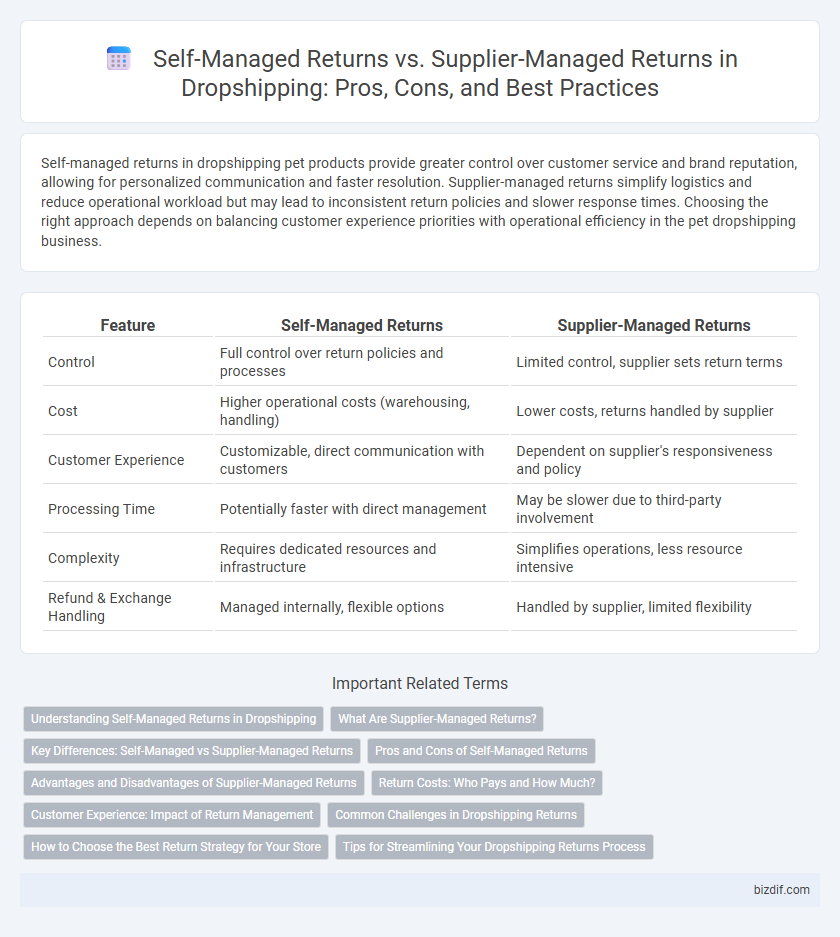Self-managed returns in dropshipping pet products provide greater control over customer service and brand reputation, allowing for personalized communication and faster resolution. Supplier-managed returns simplify logistics and reduce operational workload but may lead to inconsistent return policies and slower response times. Choosing the right approach depends on balancing customer experience priorities with operational efficiency in the pet dropshipping business.
Table of Comparison
| Feature | Self-Managed Returns | Supplier-Managed Returns |
|---|---|---|
| Control | Full control over return policies and processes | Limited control, supplier sets return terms |
| Cost | Higher operational costs (warehousing, handling) | Lower costs, returns handled by supplier |
| Customer Experience | Customizable, direct communication with customers | Dependent on supplier's responsiveness and policy |
| Processing Time | Potentially faster with direct management | May be slower due to third-party involvement |
| Complexity | Requires dedicated resources and infrastructure | Simplifies operations, less resource intensive |
| Refund & Exchange Handling | Managed internally, flexible options | Handled by supplier, limited flexibility |
Understanding Self-Managed Returns in Dropshipping
Self-managed returns in dropshipping require the retailer to handle the entire return process, including receiving returned items, processing refunds, and managing customer communications. This approach offers greater control over customer service quality and return policies but demands more resources and logistical coordination. Effective self-management can enhance brand reputation by providing personalized support and faster resolution times.
What Are Supplier-Managed Returns?
Supplier-managed returns refer to a dropshipping return process where the supplier, rather than the retailer, handles the return logistics, including authorization, product receipt, and refund issuance. This approach minimizes the retailer's operational burden and often ensures faster resolution due to the supplier's direct control over inventory and return policies. Efficient supplier-managed returns can enhance customer satisfaction by providing clear return guidelines and streamlining refund procedures within the dropshipping supply chain.
Key Differences: Self-Managed vs Supplier-Managed Returns
Self-managed returns in dropshipping require the retailer to handle return logistics, customer communication, and refund processing, offering greater control but increasing operational complexity. Supplier-managed returns shift these responsibilities to the supplier, streamlining the process and reducing the retailer's workload while potentially limiting feedback and customization options. Choosing between the two depends on priorities such as control, customer experience, and resource allocation in return management.
Pros and Cons of Self-Managed Returns
Self-managed returns in dropshipping offer greater control over customer service and faster resolution times, enhancing brand reputation and customer loyalty. However, this approach requires significant investment in logistics, return processing infrastructure, and may increase operational complexity and costs. Managing returns internally allows customization but risks inventory mismanagement and delayed refunds if not executed efficiently.
Advantages and Disadvantages of Supplier-Managed Returns
Supplier-managed returns streamline the refund process by directly handling product returns, reducing the administrative burden on dropshippers and enhancing customer satisfaction with faster resolutions. This approach minimizes inventory discrepancies and operational costs related to return logistics but may limit the dropshipper's control over customer service quality and return policies. Reliance on suppliers for returns can also introduce variability in handling times and inconsistent experiences across different suppliers.
Return Costs: Who Pays and How Much?
In dropshipping, return costs vary significantly between self-managed and supplier-managed returns. With self-managed returns, the retailer absorbs the return shipping expenses and restocking fees, which can impact profit margins. Supplier-managed returns typically shift these costs to the supplier, reducing financial risk for the retailer but potentially limiting control over return policies and customer service quality.
Customer Experience: Impact of Return Management
Self-managed returns empower customers with direct control over the return process, enhancing transparency and satisfaction through quicker resolutions. Supplier-managed returns, while reducing operational burden on sellers, may introduce delays or miscommunication affecting customer trust and experience. Efficient return management directly impacts customer loyalty and repeat purchases in dropshipping businesses.
Common Challenges in Dropshipping Returns
Self-managed returns in dropshipping often pose challenges such as increased operational workload, complex inventory tracking, and slower refund processing times that can impact customer satisfaction. In contrast, supplier-managed returns may lead to reduced control over return policies and potential communication delays but streamline the logistics by leveraging the supplier's infrastructure. Both approaches struggle with inconsistent return requirements, varying shipping costs, and the risk of lost or damaged products during transit.
How to Choose the Best Return Strategy for Your Store
Choosing between self-managed returns and supplier-managed returns depends on your store's scale, customer service capacity, and control preferences. Self-managed returns offer greater control and faster resolution but require more resources and infrastructure to handle processing efficiently. Supplier-managed returns minimize operational burden and simplify logistics but may lead to longer refund times and less direct customer communication, impacting satisfaction.
Tips for Streamlining Your Dropshipping Returns Process
Streamline your dropshipping returns by implementing clear return policies that specify whether returns are self-managed or supplier-managed to reduce confusion and improve customer satisfaction. Automate return tracking and communication using integrated software tools to ensure faster processing and transparency. Collaborate closely with suppliers to align on return procedures and timelines, minimizing delays and operational bottlenecks.
Self-Managed Returns vs Supplier-Managed Returns Infographic

 bizdif.com
bizdif.com